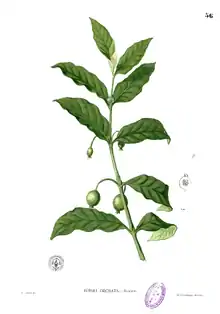Randia (plant)
Randia, commonly known as indigoberry,[2] is a mostly Neotropical genus of shrubs or small trees in the Rubiaceae. As of February 2022 Plants of the World Online lists a total of 112 accepted species in the genus.[3] Several Australian species have been reassigned to the genus Atractocarpus. These include the garden plants Atractocarpus chartaceus and A. fitzalanii.
| Randia | |
|---|---|
 | |
| Randia densiflora | |
| Scientific classification | |
| Kingdom: | Plantae |
| Clade: | Tracheophytes |
| Clade: | Angiosperms |
| Clade: | Eudicots |
| Clade: | Asterids |
| Order: | Gentianales |
| Family: | Rubiaceae |
| Subfamily: | Ixoroideae |
| Tribe: | Gardenieae |
| Genus: | Randia L.[1] |
| Species | |
|
Many, see text. | |
| Synonyms | |
|
Basanacantha Hook.f. | |
Carl Linnaeus retained the name Randia, applied by Houston to commemorate Isaac Rand.[4]
Species of this genus are generally dioecious, with separate male and female plants, although exceptions exist. They are trees, shrubs, and lianas, and may be deciduous or evergreen.[5]
Selected species
|
|
Formerly placed here
- Atractocarpus benthamianus (F.Muell.) Puttock (as R. benthamiana F.Muell.)
- Atractocarpus carolinensis (Valeton) Puttock (as R. carolinensis Valeton)
- Atractocarpus chartaceus (F.Muell.) Puttock (as R. chartacea (F.Muell.) F.Muell.)
- Atractocarpus crosbyi (Burkill) Puttock (as R. crosbyi Burkill)
- Atractocarpus decorus (Valeton) Puttock (as R. decora Valeton)
- Atractocarpus fitzalanii (F.Muell.) Puttock (as R. fitzalanii (F.Muell.) Benth.)
- Atractocarpus hirtus (F.Muell.) Puttock (as R. hirta (F.Muell.) F.Muell.)
- Atractocarpus macarthurii (F.Muell.) Puttock (as R. macarthurii F.Muell.)
- Atractocarpus sessilis (F.Muell.) Puttock (as R. sessilis F.Muell.)
- Atractocarpus stipularis (F.Muell.) Puttock ex P.S.Green (as Randia stipularis F.Muell.)
- Atractocarpus tahitiensis (Nadeaud) Puttock (as R. tahitiensis Nadeaud)
- Atractocarpus tenuiflorus (A.C.Sm.) Puttock (as R. tenuiflora A.C.Sm.)
- Atractocarpus versteegii (Valeton) Puttock (as R. versteegii Valeton)
- Aidia cochinchinensis Lour. (as R. henryi E.Pritz. or R. cochinchinensis (Lour.) Merr.)
- Aidia genipiflora (DC.) Dandy (as R. genipiflora DC.)
- Benkara malabarica (Lam.) Tirveng. (as R. malabarica Lam.)
- Benkara sinensis (Lour.) Ridsdale (as R. sinensis (Lour.) Schult.)
- Catunaregam spinosa (Thunb.) Tirveng. (as R. dumetorum (Retz.) Poir. or R. spinosa (Thunb.) Poir.)
- Catunaregam tomentosa (Blume ex DC.) Tirveng. (as R. tomentosa (Blume ex DC.) Hook.f.)
- Coddia rudis (E.Mey. ex Harv.) Verdc. (as R. rudis E. Mey. ex Harv.)
- Porterandia penduliflora (K.Schum.) Keay (as R. penduliflora K.Schum. or R. sericantha K.Schum. ex Engl.)
- Rosenbergiodendron formosum (Jacq.) Fagerl. (as R. formosa (Jacq.) K.Schum. or R. mussaenda (L.f.) DC.)
- Rosenbergiodendron longiflorum (Ruiz & Pav.) Fagerl. (as R. ruiziana DC.)
- Rothmannia longiflora Salisb. (as R. maculata DC.)
- Rothmannia whitfieldii (Lindl.) Dandy (as R. malleifera (Hook.) Benth. & Hook.f.)
- Tamilnadia uliginosa (Retz.) Tirveng. & Sastre (as R. uliginosa (Retz.) Poir.)[7]
References
Wikimedia Commons has media related to Randia.
Wikispecies has information related to Randia.
- "Genus: Randia L." Germplasm Resources Information Network. United States Department of Agriculture. 17 September 1996. Retrieved 30 August 2010.
- "Randia". Integrated Taxonomic Information System. Retrieved 30 August 2010.
- "Randia". Plants of the World Online. Royal Botanic Gardens, Kew. 2022. Retrieved 1 February 2022.
- Boulger, George Simonds (1896). . In Lee, Sidney (ed.). Dictionary of National Biography. Vol. 47. London: Smith, Elder & Co.
- Gustafsson, Claes G. R. (2000). "Three New South American Species of Randia (Rubiaceae, Gardenieae)". Novon. 10 (3): 201–208. doi:10.2307/3393100. JSTOR 3393100.
- Yetman, David (2002). The Guarijios of the Sierra Madre: Hidden People of Northwestern Mexico. UNM Press. p. 222. ISBN 9780826322340.
- "GRIN Species Records of Randia". Germplasm Resources Information Network. United States Department of Agriculture. Retrieved 10 December 2010.
- Gustafsson, C.; C. Persson (2002). "Phylogenetic relationships among species of the neotropical genus Randia (Rubiaceae, Gardenieae) inferred from molecular and morphological data". Taxon. 51 (4): 661–674. doi:10.2307/1555021. JSTOR 1555021.
- Borhidi, A.; N. Diego-Pérez (2004). "El género Randia L. (Rubiaceae, Gardenieae) en la flora del estado Guerrero (Mexico)". Acta Botanica Hungarica. 46 (1–2): 41–53. doi:10.1556/abot.46.2004.1-2.4.
This article is issued from Wikipedia. The text is licensed under Creative Commons - Attribution - Sharealike. Additional terms may apply for the media files.